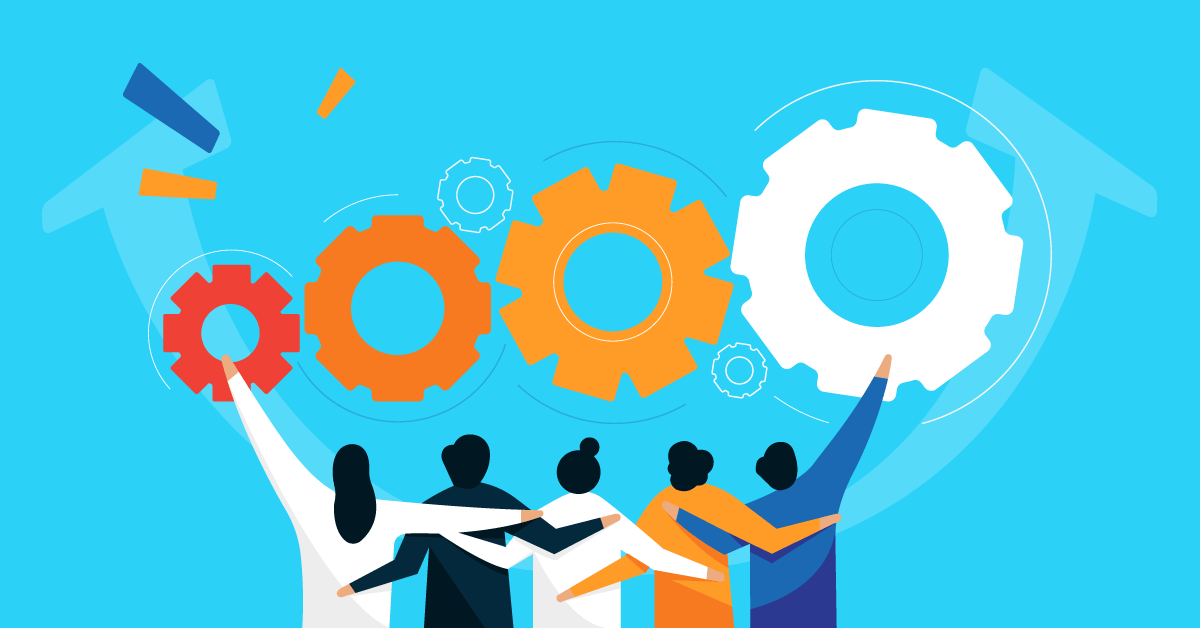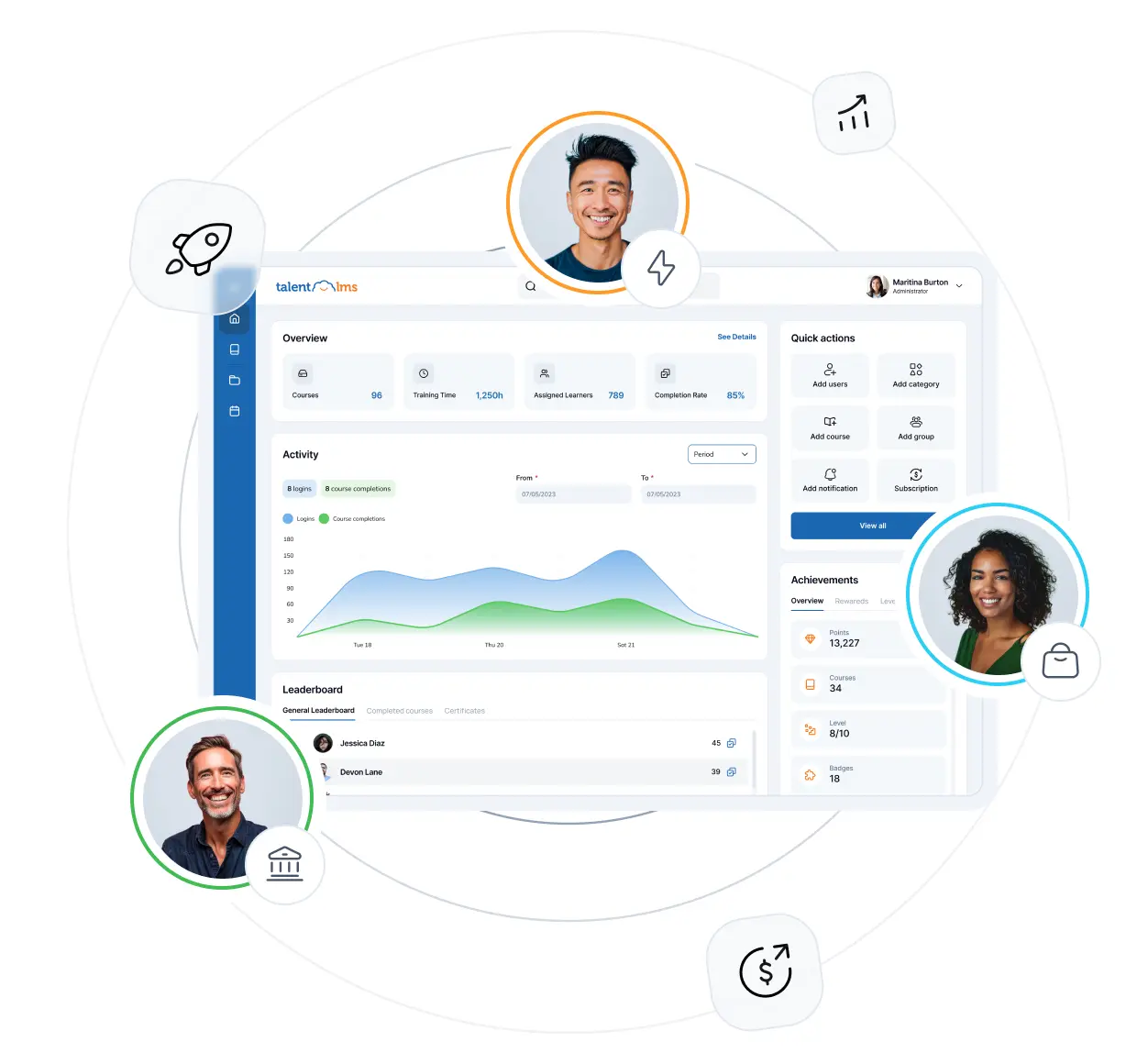- What are employee strengths?
- How can developing employee strengths benefit your organization?
- How to identify employee strengths and weaknesses
- How to help employees develop their strengths
- 22 examples of employee strengths
- The other side of the coin: 5 examples of employee weaknesses
- How to turn weaknesses into employee strengths
- Essential employee strengths: The top 5 work-related strengths
- Building a culture of turning weaknesses into strengths
Your organization is only as good as your employees. Your people make everyday operations run smoothly and bring results to your company. Each individual possesses employee strengths that critically contribute to the company’s goals.
Let’s look at how to grow strong teams, the employee strengths every company should acknowledge, and how to turn weaknesses into strengths.
What are employee strengths?
Employee strengths are the natural talents, skills, and abilities that an individual brings to the workplace and excels at. These strengths can be technical (like software proficiency) or soft skills (like communication skills or teamwork).
Work-related strengths are the qualities that enable employees to perform their jobs effectively and efficiently, contributing to their overall success and the success of the organization.
How can developing employee strengths benefit your organization?
Developing crucial employee strengths is a win-win for both your organization and your workforce. By focusing on what employees do best, you unlock a treasure trove of benefits, including the following:
- Increased productivity and performance. Research shows that when people use their strengths, their job performance improves. Employees who know their strengths, as well as, their weaknesses, may be more willing to learn from their mistakes. They’re open to training that will help them improve their skill set, thus, their overall performance and expertise.
- Enhanced innovation and problem-solving. A diverse workforce brings a wider range of strengths and perspectives. This means greater creativity and more innovative solutions.
- Improved employee engagement and retention. Employees who feel their strengths are valued are more engaged. They’re more likely to experience job satisfaction and be committed to their roles.
- Stronger teams and collaboration. When employees understand and appreciate each other’s strengths, collaboration becomes smoother.
How to identify employee strengths and weaknesses
Recognizing employee strengths is the first step toward building a thriving team. But how do you uncover these hidden gems?
Here are some effective strategies:
- Conduct performance reviews and feedback sessions. Regular performance reviews and feedback sessions provide a platform for open conversations about an employee’s strengths and weaknesses.
- Perform skills assessments and surveys. Skills gap assessments and surveys can measure technical skills, communication skills, and problem-solving abilities.
- Gather observation and feedback from colleagues. Pay attention to how employees interact and collaborate. Who takes the lead on problem-solving? Who excels at written communication? Ask for constructive feedback from colleagues who work closely with your team to gain a well-rounded perspective.
Implementing these strategies gives you a comprehensive picture of employee strengths.
How to help employees develop their strengths
Employee strengths aren’t just natural gifts or personality traits. They’re trainable skills. And with some advanced planning, you can ensure your L&D strategy supports a culture that values and encourages individual strengths.
Here are three ways to build essential employee strengths at work.
1. Create targeted training programs
Provide opportunities for employees to refine their employee strengths through workshops, online courses, or certifications relevant to their specific jobs.
Once you know the employee strengths you want to build and the gaps you need to fill, develop training programs that help amplify employee strengths. For example, you might have discovered your sales team lacks communication skills and teamwork. In that case, you could include a training course on soft skills in your LMS and offer additional resources to help your employees progress.
2. Apply mentorship and coaching programs
Pair newer or more junior employees with those who exhibit the employee strengths you want to develop. Having one-on-one time with more experienced colleagues, whether through coaching sessions or job shadowing, lets employees see the strengths in the workplace.
As a bonus, this development approach can build collaboration. It helps both mentors and employees view things from different perspectives and form stronger professional relationships.
3. Recognize achievements
When encouraging employees to use their strengths at work, acknowledge and reward them. Recognition motivates people to continue nurturing strengths. And sharing examples of employee strengths can inspire your team further.
In addition, finding and implementing ideas for employee appreciation can boost employee morale. When employees feel appreciated, they’re more satisfied and confident at work. And that helps them enhance productivity and achieve excellence.

22 examples of employee strengths
Building strengths is important for every person in your team, regardless of their role, seniority, or field. Here are 22 key employee strengths to look for and cultivate:
1. Accountability
You need dependable employees who show accountability when problems arise. Reliable and loyal employees demonstrate ownership. They are punctual and consistent, meet deadlines, and provide high-quality work.
When team members are accountable, you and their colleagues know you can depend on them. Having trustworthy employees helps develop strong work relationships and ensures efficiency.
2. Flexibility and adaptability
Times change, tasks change, markets change. You need employees who can adapt quickly and easily to any shifts in the workplace.
The ability to adapt quickly allows employees to embrace new technologies, processes, and market trends. This agility helps organizations stay competitive and respond effectively to unforeseen circumstances.
3. Motivation
Self-motivated employees perform without having managers or supervisors constantly reminding them to strive for excellence. They’re dedicated professionals who deliver high-quality work and perform with consistency.
Motivated employees keep business moving forward as usual, keeping your company running smoothly and efficiently.
4. Teamwork
Successful employees collaborate effectively with others, share ideas openly, and work toward achieving common goals.
Teamwork is one of the most important employee strengths for many projects. Employees who can work seamlessly with colleagues, share credit for successes, and offer constructive support contribute to a positive, team-oriented work environment.
5. Communication skills
Teamwork and success are impossible without communication skills. Long-term goals are difficult to achieve if there are issues in communication between employees.
The ability to convey ideas clearly and concisely, both verbally and in writing, is essential for collaboration and information sharing. Good communication skills ensures everyone is on the same page, reduces misunderstandings, and encourages collaboration.
6. Problem-solving
Effective employees can identify, analyze, and solve problems creatively and efficiently. People with problem-solving skills and decision-making abilities understand circumstances and obstacles, but also benefits and positive outcomes.
Inescapable challenges arise in any workplace. Employees who approach problems methodically and creatively save time, minimize disruptions, and contribute to continuous improvement.
7. Empathy and emotional intelligence
Understanding and managing one’s own emotions, as well as recognizing and responding to others’ emotions with empathy, fosters positive working relationships.
Emotional intelligence helps employees build rapport with colleagues and clients, navigate conflict constructively, and create a more harmonious workplace.
8. Critical thinking
The ability to assess information objectively, consider different perspectives, and make sound judgments is vital for informed decision-making.
Critical thinkers weigh the pros and cons of various options, identify potential risks, and make well-reasoned decisions that benefit the organization. This boosts their problem-solving skills.
9. Organization
Strong organizational skills allow employees to prioritize and complete tasks, manage their time effectively, and meet deadlines.
Organized employees are more productive, reduce stress for themselves and colleagues, and can handle multiple tasks simultaneously without dropping the ball.
10. Time management
The ability to prioritize tasks, manage deadlines, and avoid procrastination makes your organization more productive.
Effective time management ensures projects stay on track, deadlines are met, and employees are not overwhelmed. This creates a smoother workflow and reduces last-minute scrambling.
11. Leadership skills
The ability to inspire, motivate, and guide others is a valuable asset, even outside formal leadership roles.
Leaders can set a positive example, encouraging and empowering employees to reach their full potential and navigate challenges. Leadership skills are not limited to hierarchical positions. Anyone can take initiative and guide others toward a common goal.

TalentLibrary – Skills that matter, courses that deliver
With TalentLibrary, you set the foundation for a strong, aligned workforce—soft skills, compliance, and workplace essentials, from day one (and beyond).
12. Dependability
Reliable employees are trustworthy, meet their commitments, and take responsibility for their work.
A dependable, trustworthy employee inspires confidence within the team. They consistently deliver high-quality work on time, allowing colleagues to rely on them and reducing the need for micromanagement.
13. Initiative
Employees who take initiative, anticipate needs, and go the extra mile are valuable assets to any team.
Employees with initiative solve problems independently, identify areas for improvement, and demonstrate a proactive approach to their work. This employee strength can lead to increased efficiency and innovation.
14. Creativity
The ability to think outside the box and generate new ideas drives innovation and problem-solving.
Creative employees develop thoughtful solutions, identify new market opportunities, and contribute to a culture of continuous improvement.
15. Learning agility
A willingness to learn new skills and adapt to changing technologies is key for personal and professional growth.
Employees who can learn quickly stay up-to-date in their field, adopt new technologies seamlessly, and adapt to evolving business needs.
16. Growth mindset
Employees with a growth mindset believe they can develop their abilities, so they have a positive attitude toward challenges and setbacks.
A growth mindset encourages people to embrace challenges as opportunities to learn and improve. As a result, they show greater resilience and perseverance in the face of challenges and setbacks.
17. Attention to detail
A focus on accuracy and quality is essential for many roles, particularly those involving data analysis or technical tasks.
People with a keen eye for detail ensure tasks are completed correctly and thoroughly, minimizing errors and the respective effort of additional rounds of feedback. They use their employee strengths to maintain data integrity and uphold quality standards.
18. Analytical skills
The ability to collect and interpret data helps people make informed decisions.
Strong analytical skills allow employees to identify trends, assess risks and opportunities, and make data-driven decisions that benefit the organization.
19. Resilience
The ability to bounce back from setbacks and maintain a positive attitude helps people overcome challenges.
Resilient employees navigate challenges without becoming discouraged. They learn from setbacks, adapt their approach, and persevere in the face of difficulty.
20. Work ethic
A strong work ethic demonstrates a commitment to excellence and dedication to one’s role.
Employees with a strong work ethic are reliable, take pride in their work, and consistently deliver high-quality results. Their dedication inspires trust and motivates others on the team.
21. Customer focus
The ability to understand and prioritize customer needs is one of the key strengths of an employee who deals with client satisfaction.
Team members with a customer focus build strong relationships with clients, anticipate their needs, and provide exceptional service. Their employee strengths lead to increased customer satisfaction, stronger loyalty, and positive word-of-mouth.
22. Technical skills
While specific skills vary depending on the role, a strong foundation in relevant technical skills is important for many positions.
Employees with the necessary job-related skills perform their jobs effectively. They can troubleshoot problems independently, become mentors who help those in need, and contribute to the organization’s overall efficiency.
The other side of the coin: 5 examples of employee weaknesses
While recognizing employee strengths is crucial, acknowledging weaknesses is equally important for well-rounded employee development. Here are five common employee weaknesses to be aware of:
- Procrastination and poor time management. Difficulty prioritizing tasks, meeting deadlines, and managing time effectively can lead to missed deadlines and workflow disruptions.
- Communication issues. Unclear written or verbal communication can lead to misunderstandings and hinder collaboration.
- Resistance to change. Employees who struggle to adapt to new processes, technologies, or leadership styles can hinder team progress.
- Lack of delegation. The inability to effectively delegate tasks can lead to burnout and missed deadlines. It can also hinder others’ growth.
- Micromanagement. Excessive control shows a lack of trust in colleagues. It can stifle creativity and damage team morale.
The good news? These weaknesses are opportunities for growth. Identifying them and creating a development plan allows you to turn them into key strengths.
How to turn weaknesses into employee strengths
Transforming weaknesses into strengths takes a two-pronged approach:
Targeted training and professional development
Identify specific weaknesses and offer targeted training, workshops, or mentorship programs. Help your teams answer the questions, “What are my strengths at work?” and “What employee strengths do I want to develop?”
Mentorship helps them see employee strengths examples at work, and training equips them with the skills and knowledge to overcome their weaknesses.
Supportive work environment
Provide opportunities for employees to practice and develop their weaker areas. This could involve assigning tasks that stretch their abilities in a supportive environment or offering opportunities to shadow colleagues with complementary strengths.
Essential employee strengths: The top 5 work-related strengths
While the most vital employee strengths vary depending on the specific role, there are in-demand employee skills that benefit most organizations. Here are five top employee strengths in the workplace:
- Critical thinking. Employees who can assess information objectively, consider different perspectives, and weigh potential risks and rewards make well-reasoned decisions.
- Creative thinking. The ability to generate new ideas, tackle problems creatively and help teams overcome challenges through continuous innovation.
- Communication. Clear written and verbal communication ensures everyone is working toward the same goals and collaborating.
- Teamwork. Successful collaboration, including sharing ideas openly and working toward company goals, strengthens team effectiveness.
- Dependability. Reliable employees who meet deadlines, take responsibility, and consistently deliver high-quality work inspire trust and confidence within the team.
Building a culture of turning weaknesses into strengths
When employees use their strengths on the job, the entire organization benefits. Your teams become more agile, creative, and competitive. This translates into better employee engagement, motivation, retention, and as a result, better ROI.
Therefore, your employees should be able to identify weaknesses and assist in making these weaknesses into key strengths makes for a productive workplace, achieves personal growth, and takes your business forward.
Building and nurturing a company culture that values employee strengths and overcomes weaknesses creates a high-performing team poised for organizational success.
Originally published on: 12 Dec 2022 | Tags: Employee development,Employee strengths


